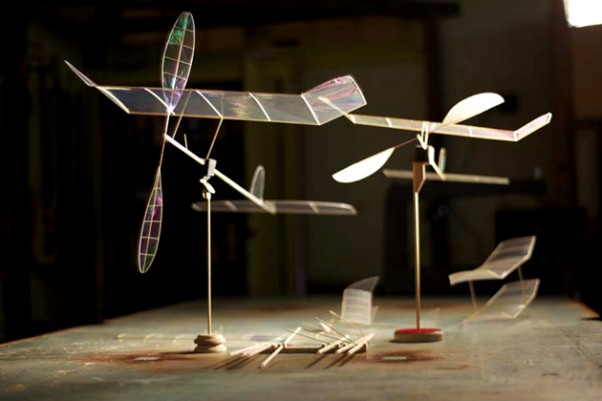When I first read the term “indoor freeflight rubber-powered duration aircraft” a couple weeks ago, several questions popped up into my head about what it entailed, but I wasn’t quite my interest wasn’t exactly captured yet. Then I saw the video, and I was pretty blown away.
There are many ways to practice one’s passion for aviation. I personally enjoy planespotting and aviation history, as well as some model building. There are tons of other forms, and though they aren’t all for me, I admire those other areas and can relate to the passion with which people practice it. But every now and then something comes along that really piques my curiosity and I don’t even realize how big I’m smiling until my face starts to hurt a little. Rubber-powered flight is now among them.
The Nuts and Bolts
Frankly, there aren’t any nuts and bolts, and these are not the cheap wood and rubber band planes you played with as a kid, or today steal from your nephew so you can play on your own. These aircraft are constructed from very light balsawood sheet and strip, boron filament, carbon fiber and a transparent covering of plastic film less than 0.5 micrometers thick. These materials are extremely light, and keep the airframe to the minimum 1.2 gram weight (the weight of a dollar bill), while having maximum limits of a wingspan of 55 cm and 20 cm wing chord.
The rubber bands used are also incredibly unique. At 9 inches long they weigh-in at no more than 0.6 grams and made from the same rubber used in the core of golf balls. To power the aircraft, they are twisted by a machine anywhere from 1500-2000 times and unwind at a rate of 40-50RPMs, which means, yes, the propellers unwind THAT slow and the video is NOT in slow motion! I was amazed to learn that the rubber used is similar to wine in that some years of production were better than others, with the best batch having been made in May of 1999. They are preserved in freezers, and help keep the aircraft aloft for close to forty minutes.
The duration competitions are governed by the Swiss-based FAI (Fédération Aéronautique Internationale) [link], with F1D being the designator for the indoor freeflight rubber-power duration aircraft. Hobbyists and competitors must practice in large open indoor areas such as airport hangars. Locally, the very hangar once used by the Hindenburg at NAS Lakehurst, NJ., is where hobbyists can test their creations. Among other locations used are the incredible salt mines in Romania, 400 ft underground, which has hosted the world championships several times.
To add to the hobby’s history, and to point out its relevance in aviation history as well, the first powered, fixed wing flying device capable of stable flight was the Planophore model airplane designed by Alphonse Pénaud in 1871, which was powered by a rubber band. His design directly influenced the Wright Brothers, who of course took to the skies in the early 1900s, also the same decade that rubber-powered flying became competitive.
The FLOAT Documentary
I learned about this fascinating hobby when I heard of the fundraiser for FLOAT, a documentary being made by F1D enthusiasts Ben Sacks and Phil Kibbe. The documentary will follow three competitors representing the U.S. as they prepare for and fly to the F1D World Championships this August in Belgrade, Serbia. They are excited to show off not only the hobby and fierce competition, but the people behind it and the relationships that they build that are so very similar to the strong friendships and camaraderie I’ve experienced in my years as a planespotter. In fact, much of the footage is shot with the same Digital SLR cameras that we also employ for aviation photography.
Phil, Ben and Jack have a Kickstarter fundraising page for the film, where they aim to raise $30,000 to help fray the costs of production, as well as airfare, hotels and everything that goes along with sending three talented enthusiasts halfway across the globe to represent the United States among a skilled flyers and passionate aviation enthusiasts.
How has this hobby within aviation enthusiasm escaped me so long? I have no idea, but I would love to see this documentary get off the ground (See what I did there?). I’m not surprised that, as of press time, they’re within $2,000 of their goal, with 5 days remaining, but I urge all that can contribute to help make their project progress. Please visit their Kickstarter to learn more and contribute before their deadline of July 4th.







